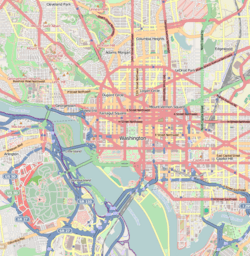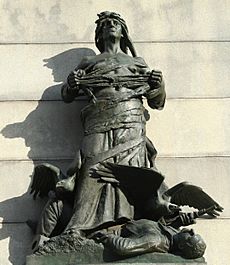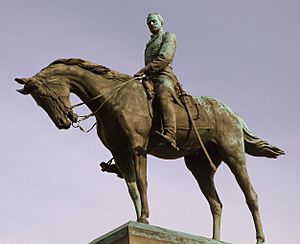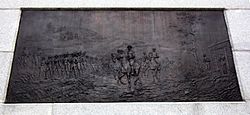General William Tecumseh Sherman Monument facts for kids
Quick facts for kids General William Tecumseh Sherman Monument |
|
|---|---|
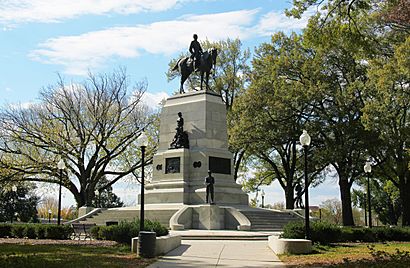 |
|
| Artist | Carl Rohl-Smith, others |
| Year | 1903 |
| Type | Bronze and granite |
| Location | Washington, D.C. |
| Owner | National Park Service |
|
General William Tecumseh Sherman Monument
|
|
|
U.S. Historic district
Contributing property |
|
| Location | Washington, D.C. |
| Part of | Civil War Monuments in Washington, DC |
| NRHP reference No. | 78000257 |
| Added to NRHP | September 20, 1978 |
The General William Tecumseh Sherman Monument is a large statue in Washington, D.C.. It shows William Tecumseh Sherman riding a horse. Sherman was a very important general during the American Civil War.
The monument is located in Sherman Plaza, which is part of President's Park. Choosing the artist for this monument in 1896 was a big deal. The main artist, Carl Rohl-Smith, sadly passed away before it was finished. Other sculptors then helped to complete his work. The statue was officially shown to the public in 1903. It is a special part of the Civil War Monuments in Washington, D.C. and President's Park South, both listed as historic places.
Contents
Building the Sherman Monument
Carl Rohl-Smith, the original artist, died in August 1900. Even though his contract ended with his death, a special committee allowed his wife, Sara Rohl-Smith, to make sure the statue was finished.
Mrs. Rohl-Smith asked other sculptors to help. These included Theo Kitson, Lauritz Jensen, and Stephen Sinding. Sinding created plaster models for the War and Peace figures. However, their size and positions didn't quite fit the monument. So, Sigvald Asbjornsen reshaped them. Asbjornsen also finished one of the four soldier figures on the monument's corners.
Theo Kitson created the round medallions. These showed the commanders who worked under General Sherman. Lauritz Jensen finished four large panels that tell stories. He also completed the eagle badge of the Army of the Tennessee.
The statues and medallions were cast (made from metal) by Gorham Brothers in Connecticut.
The Monument's Base
The stone base for the statue was designed by Rohl-Smith. It was built by the Harrison Granite Company using granite from Massachusetts. A colorful mosaic around the base was also designed by Rohl-Smith. The National Mosaic Company built it.
The monument was expected to cost $90,000. But the final cost was a bit higher, at $123,969.91.
Dedication and Location
President Theodore Roosevelt officially dedicated the monument on October 15, 1903. The monument stands in Sherman Park. This area is historically important. General Sherman, President Andrew Johnson, and General Ulysses Grant reviewed the Army of the Potomac here in 1865. Sherman also led his own Army of the Tennessee past this spot the very next day.
In 1904, the area around the monument was officially named "Sherman Plaza" by Congress. In 2011, the statue was cleaned and repaired in a $2 million project.
The monument is a key part of the Civil War Monuments in Washington, D.C.. It is also part of President's Park South, another historic area.
What the Monument Looks Like
The Sherman Monument is located where 15th Street NW, Pennsylvania Avenue NW, and Treasury Place NW meet.
The statue of General Sherman on his horse is about 17 feet 6 inches (5.3 meters) tall. It sits on a granite base that is 25 feet 4 inches (7.7 meters) high. The War and Peace statues are each 9 feet 6 inches (2.9 meters) tall. The four soldier statues at each corner are 7 feet (2.1 meters) tall.
The large story panels, like March Through Georgia, are about 7 feet 6 inches (2.3 meters) by 3 feet 9 inches (1.1 meters). Smaller panels, like Sherman By the Campfire, are 4 feet (1.2 meters) by 3 feet 9 inches (1.1 meters). The Army of the Tennessee badge is 5 feet (1.5 meters) by 1 foot 6 inches (0.46 meters). The round medallions are 1 foot 3 inches (0.38 meters) square.
The entire monument, from the front step to the back, is about 59 feet 8 inches (18.2 meters) long. The flat area around the base is 41 feet (12.5 meters) long.
The Foundation
The monument's underground foundation was finished in 1898. Workers dug out a lot of earth and used many wooden poles driven into the ground to support the heavy monument. They also used a lot of sand, fill, and concrete. They had to dig deeper than planned because of groundwater. This cost an extra $10,000.
Rohl-Smith designed the statue to show Sherman riding down Pennsylvania Avenue. This happened on May 24, 1865, when he led his Army of the Tennessee in a grand parade.
Story Panels and Figures
Four large panels, called bas-reliefs, are on the sides of the monument. They show important moments from Sherman's life:
- North side: The March Through Georgia shows soldiers happily marching through enemy land. Sherman and his staff are in the background. Former slaves watch in wonder as Sherman's troops pass by.
- South side: The Battle of Atlanta shows Sherman and his staff listening to cannons. This is at his headquarters during the battle. Other generals are there, getting updates. In the back, soldiers are fighting, saving the Army of the Tennessee from defeat.
- West side: Sherman by the Campfire shows Sherman standing or walking by a campfire at night. This is based on a story from one of his officers.
- East side: Missionary Ridge shows the Battle of Missionary Ridge from November 25, 1863. Sherman is waiting for news during the fight. His troops are shown battling on the ridge.
There are two main groups of figures on the monument:
- The western group shows War. It depicts an older woman tearing her clothes. She is stepping on a dead soldier. A vulture is nearby, showing the harshness of war. This represents Sherman's famous saying, "War is hell!"
- The eastern group shows Peace. It depicts a young woman holding a flowering branch. A young girl cares for a wounded boy, showing how the strong help the weak. Another boy feeds a bird, symbolizing peace and nature.
Four figures stand at each corner of the monument. They represent different parts of the army:
- Artillery (northeast corner)
- Infantry (northwest corner)
- Cavalry (southeast corner)
- Engineers (southwest corner)
Pairs of medallions on each side show important army and corps commanders. These include General James B. McPherson, General Oliver O. Howard, General John A. Logan, and others.
The Mosaic Base
Rohl-Smith planned for a mosaic to surround the monument. His wife, Sara Rohl-Smith, designed the actual pattern for this mosaic. Congress provided extra money to finish it.
The mosaic lists the names of battles Sherman fought in:
- North side: Battles like Griswoldville, Waynesboro, and the Capture of Savannah.
- East side: Battles like Kenesaw Mountain (spelled "Kenesaw" on the monument), Peach Tree Creek, and the Capture of Atlanta.
- South side: Battles like Chattanooga, Missionary Ridge, and the Relief of Knoxville.
- West side: Battles like Bull Run, Shiloh, and the Vicksburg.
Words are also carved around the base of the monument:
(Base, front:)
WILLIAM TECUMSEH SHERMAN
1820–1891(North side of base:)
ON NO EARTHLY ACCOUNT WILL I DO ANY ACT OR
THINK ANY THOUGHT HOSTILE TO OR IN DEFIANCE
OF THE OLD GOVERNMENT OF THE UNITED STATES
ALEXANDRIA, LOUISIANA JANUARY 18, 1861
WAR'S LEGITIMATE OBJECT IS MORE PERFECT PEACE
WASHINGTON, DC FEBRUARY 23, 1882(South side of base:)
SEMINOLE WAR 1840–1842
WAR IN MEXICO 1847–1848
OCCUPATION OF CALIFORNIA
CIVIL WAR 1861–1865
GENERAL COMMANDING THE
ARMY OF THE UNITED STATES
1869–1884(South base, lower side:)
ERECTED BY THE
SOCIETY OF THE ARMY OF THE TENNESSEE
WITH THE AID OF THE
CONGRESS OF THE UNITED STATES
1903
See also
 In Spanish: Monumento al general William Tecumseh Sherman para niños
In Spanish: Monumento al general William Tecumseh Sherman para niños


